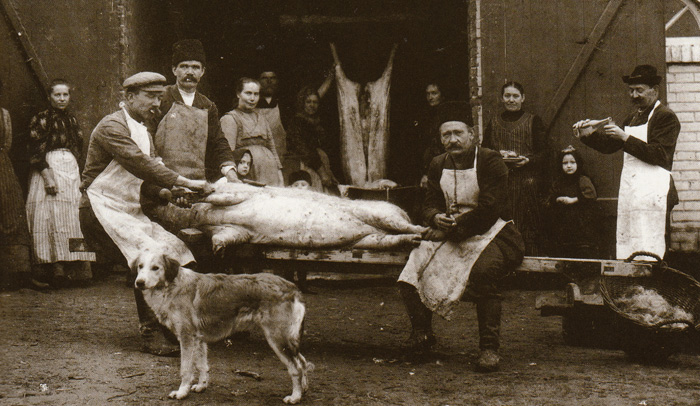Village News
Mennonites and Beer Steins

According to the Global Anabaptist Mennonite Encyclopedia Online (GAMEO), the saying “Anyone who is a genuine Mennonite must be able to hold his drinks” is attributed to Dutch Mennonites of Northeast Germany. It may surprise some to know that the supposed connection between Mennonite culture and sobriety is a relatively recent one. Even Steinbach, which had a reputation for being a “dry” town until just a few years ago, was not always as “dry” as many have assumed.
Recently, Mennonite Heritage Village (MHV) accepted a donation of two glass beer steins discussed recently by Erin Unger in a blog entitled “Interesting Items I’ve Found at the Steinbach MCC” (Mennotoba.com). By all appearances, these steins may be souvenir items produced by MHV in 1974 to celebrate the centenary of the first Mennonite migration from Russia to Manitoba (or alternately might just be samples left by a souvenir sales representative). The two steins feature two different designs, each featuring different images of the museum’s auditorium (which in 1974 was referred to as the Artefact Building) and its windmill. We know little as to why MHV would have chosen to distribute beer steins for this celebration, or whether in fact they did, but this certainly does add an intriguing take on the assumed “dry” history of Mennonites. Inspired by the beer steins, I decided to see what information I could find on the relationship between Mennonites and alcohol to determine if Mennonites truly do have a “dry” history.
Historically, Mennonites are not a “sober” people. In fact, the consumption and creation of alcoholic beverages by Mennonites stretches far back to their time in the Vistula Delta (or Northeast Germany) in the eighteenth century, particularly in and around the city of Danzig (now Gdańsk, Poland). One of the earliest known Mennonite distilleries in Danzig was Ambrosius Vermeulen’s Zum Lachs, which produced “Goldwasser” liqueur, a brandy with floating flecks of gold. The brandy became famous, and the business was run by Mennonites for two centuries.
However, Mennonites did not distill and sell liquor because of a particular interest in the business. Rather, it was one of the few vocations available to Mennonite trades and craftsmen due to the increasingly rigid rules of trade guilds in Danzig. Nevertheless, the responsible consumption of liquor was accepted by the Mennonite community and the church — alcohol and tobacco were available at the West Prussian and Danzig church board meetings, and ministers and elders of Mennonite congregations even participated in family distillery businesses.
The liquor business among Mennonites migrated with them to Russia in the nineteenth century. By 1819 there were several Mennonite brewers in the Chortitza Colony, and many Mennonite villages had “drinking houses.” Brandy was passed around at funerals, and schnapps was served at Faspa. In the mid-nineteenth century, the Kleine Gemeinde congregation took a firm stand against tobacco and drinks with high alcohol content but didn’t outright forbid wine and beer. Upon settling in North America, many members of the Kleine Gemeinde were influenced by the temperance movement and formed even stricter attitudes against alcohol.
How strict these attitudes were is up for debate. Some historical sources say no alcohol was to be found in entire villages, others say wine was served at particular occasions. One such occasion was the annual hog-butchering bee, a community event enjoyed by Mennonites in Russia and later in North America. During the butchering process, the host brought out a bottle of wine (or, on occasion, liquor), and passed it around. Every man took a swig, the size of which depended on the thickness of the pig’s bacon. According to Norma Jean Vost in Mennonite Foods & Folkways from South Russia, Volume 2, this was called “Spakj mӓte,” or “measuring the bacon.” Arnold Dyck, in Lost in the Steppe, suggests “this…went on all day, not very frequently, but frequently enough to keep everybody strong and in [a] good mood.”
In Steinbach, another example of a Mennonite community, this “good mood” is not a new sensation. The city’s first public “men’s only” beer parlor opened in the early 1930s in the Tourist Hotel on Main Street, in the very center of town. Abe Warkentin’s book Reflections on Our Heritage: A History of Steinbach and the R.M. of Hanover from 1874 informs the reader that despite a petition to have it closed down in 1950 to “take away the temptation from the younger generation,” the parlour remained open. Today, a liquor vendor can be found next to the Superstore, and many of the city’s restaurants openly serve a variety of alcoholic beverages.
We might not know for sure whether MHV commissioned a variety of beer steins for their 1974 celebration of Mennonites arriving in Canada, but it is clear that alcohol has been enjoyed by Mennonites in celebrations for centuries. If we’ve tended to forget about this long history, or maybe swept it under the rug, perhaps we should rather raise an MHV beer stein to celebrate our long and fascinating shared history.




